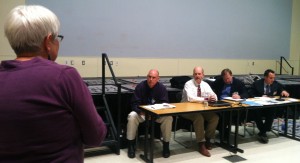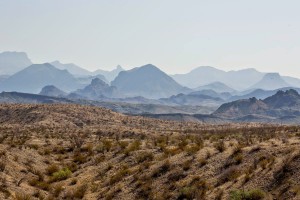As Deadline Nears for Texas Haze Rule, A Look at How Lawsuits Shape Regulation
Note: This is a text version of a previously posted radio story.
One week remains for the public to comment on an Environmental Protection Agency proposal to reduce smog in one of Texas most beloved national parks. The EPA’s plan to limit so-called ‘regional haze’ is one of a slew of new air quality rules that have critics accusing the EPA of waging a ‘war on coal.’ But the reality of environmental policy-making, and the years of lawsuits that it often entails, is more complicated than the rhetoric.
To see how, look no farther than the hazy skies over Far West Texas.
“Big Bend National Park and Big Bend State Park. They are beautiful,” says Mary Ann Melton of the region. She’s a photographer who’s been visiting there since the 1970s.
“You can see 100 miles on a clear day. You’re looking over the valley, you’re about 1800 feet high off the floor of the river, and you can see far into Mexico and mountain ranges far into Mexico.”
Just not on a recent trip last year.
“We didn’t photograph that day,” she says. “Because there was this brown haze that probably went a third of the distance from the valley floor to about a third of the way up the mountains.”
This haze is nothing new. A lot of it comes from coal power plants far away from Big Bend. State and federal officials have been trying to fight it for years, and most recently the EPA stepped in with its own proposal. That queued up some outrage in Texas over federal overreach. But the proposal wasn’t exactly the product of the EPA’s own initiative. It was prompted by a lawsuit brought against the agency by environmental groups.“When you get a plan in from the state you are required to take action,” says Guy Donaldson, who’s in charge of air quality at the EPA’s Region Six office in Dallas. “If we don’t, we are challenged and can be put on a court-ordered deadline. We are on that here.”
Donaldson says the EPA can fall behind in its regulatory duties because of a lack of “resources.”
The Ping Pong Game of Lawsuits
The closer you look at the battles over regulation being fought over the last few years, the more you see lawsuits everywhere.
“Litigation has been a big part of this process, from the very beginning,” says David Spence, a Professor of Law, Politics & Regulation at the University of Texas at Austin.
Spence says the creation of environmental policy follows “a pattern of the EPA doing some things and not doing others. And whoever is unhappy with what the EPA is doing or not doing sues to try to get the EPA to do what they want.”
You can go online and find lists of lawsuits the EPA is facing, and lists of regulations it’s gone to court over. Regulating greenhouse gases? That was Massachusetts v. EPA. Rules to limit mercury emissions? The result of legal battles going way back.
Opponents of the regulations, including the U.S. Chamber of Commerce, accuse the EPA and environmentalists of colluding in a “sue and settle” strategy to enact regulations. But the fact is it’s not only environmental groups that sue. It’s also businesses and states, and many of them are suing to weaken the rules, not strengthen them.
The legal back-and-forth is almost like a game of ping pong. Spence points to the EPA’s new mercury emissions rule as an example. He calls it “one of the more controversial rules we’re seeing right now.”
That rule was first proposed under President Bill Clinton. But the Bush administration reversed it. Environmental groups sued, and the Bush era EPA rules were struck down.
“So the current mercury rule is sort of the reviving of that first mercury rule from the Clinton administration,” says Spence.
But the EPA has been sued again over the rule. The Supreme Court just heard arguments this week from opponents saying the rule will be too costly.
So does the game of ping pong ever end?
End Game
Lawsuits may seem like a crazy way to regulate the environment. But some say they may be the only way, especially in times of political gridlock. At very least, the rules that result from legal battles have been pressure-tested. They are probably not going anywhere, no matter who is in the White House.

Mose Buchele
Representatives of the EPA hear public comment on proposed regional haze rules in Austin earlier this year.
“Once you propose and finalize a rule, it is a law, and repealing that rule involves a similar kind of process,” says Spence. “So once something is enshrined in the code of federal regulation there are transaction costs associated with getting it pulled back.”
“There is an end game, ultimately,” echoes Brad Watson. “and we’ve seen that with a couple of prominent rules.”
Watson represents some of the people who stand to lose the most from the EPA’s clean air regulations. He is a spokesman for Luminant, a company that owns coal power plants in Texas.
Luminant is opposed to the EPA’s regional haze proposal, saying it could drive electricity prices up, maybe even shut down some power plants. When the rule is finalized, Luminant and other groups will decide whether to sue. But, Watson says, Luminant is also wary of endless legal wrangling.
“Any American business likes certainty about the regulatory outlook,” he says.
As for the outlook in Far West Texas? Photographer Mary Ann Melton went back to the Big Bend this year. She says it had just rained, and the haze was not so bad.
In the long-term, the law mandates that the haze be fixed by 2064.
“So this is not a torch that I’m going to carry all the way to the finish line,” says the EPA’s Donaldson.
When asked if he was saddened by that, he replied with a chuckle.
“A little bit,” he said, “but there are other people that can pick it up.”
The EPA will received public comment on the regional haze proposal until April 20th. You can comment online here.



